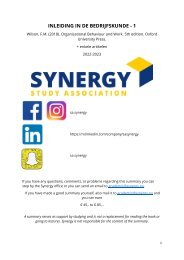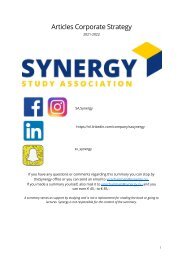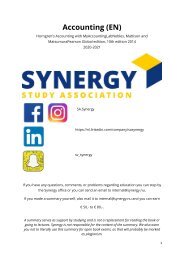Create successful ePaper yourself
Turn your PDF publications into a flip-book with our unique Google optimized e-Paper software.
adjustments, similar to changes in accounting principles. Companies record a correction of an<br />
error in the year in which it is discovered.<br />
Net income increases retained earnings. A net loss decreases retained earnings. Both cash <strong>and</strong><br />
share dividends decrease retained earnings.<br />
In some cases, companies transfer the amount of retained earnings restricted to an account<br />
titled Appropriated Retained Earnings. The retained earnings section may therefore report two<br />
separate amounts: (1) retained earnings free <strong>and</strong> (2) retained earnings appropriated. The total of<br />
these two amounts equals the total retained earnings.<br />
Comprehensive income includes all changes in equity during a period except those resulting<br />
from investments by owners <strong>and</strong> distributions to owners. Comprehensive income, therefore,<br />
includes the following: all revenues <strong>and</strong> gains, expenses <strong>and</strong> losses reported in net income, <strong>and</strong><br />
all gains <strong>and</strong> losses that bypass net income but affect equity. These items – non-owner changes<br />
in equity that bypass the income statement – are referred to as other comprehensive income.<br />
Companies must display the components of other comprehensive income in one of two ways: (1)<br />
a single continuous statement (one statement approach) or (2) two separate but consecutive<br />
statements of net income <strong>and</strong> other comprehensive income (two statement approach). The one<br />
statement approach is often referred to as the statement of comprehensive income. The two<br />
statement approach uses the traditional term income statement for the first statement <strong>and</strong> the<br />
comprehensive income statement for the second statement.<br />
In addition to a statement of comprehensive income, companies are also required to present a<br />
statement of changes in equity. The statement reports the change in each equity account <strong>and</strong> in<br />
total equity for the period. The following items are disclosed in the statement:<br />
1. Accumulated other comprehensive income for the period<br />
2. Contributions <strong>and</strong> distributions to owners<br />
3. Reconciliation of the carrying amount of each component of equity from the beginning to the<br />
end of the period.<br />
This statement is useful for underst<strong>and</strong>ing how equity changed during the period.<br />
Chapter 5 – Statement of <strong>Financial</strong> Position <strong>and</strong> Statement of Cash Flows<br />
The statement of financial position, also referred to as the balance sheet, reports the assets,<br />
liabilities <strong>and</strong> equity of a business enterprise at a specific date. This financial statement provides<br />
information about the nature <strong>and</strong> amounts of investments in enterprise resources, obligations to<br />
creditors, <strong>and</strong> the equity in net resources. It therefore helps in predicting the amounts, timing,<br />
<strong>and</strong> uncertainty of future cash flows.<br />
Analysts use the statement of financial position to assess the company’s liquidity, solvency, <strong>and</strong><br />
financial flexibility. Liquidity describes the amount of time that is expected to elapse until an<br />
asset is realized or otherwise converted into cash or until a liability has to be paid. Solvency refers<br />
to the ability of a company to pay its debts as they mature. Liquidity <strong>and</strong> solvency affect a<br />
company’s financial flexibility, which measures the ability of a company to take effective actions<br />
to alter the amounts <strong>and</strong> timing of cash flows so it can respond to unexpected needs <strong>and</strong><br />
opportunities. Generally, the greater an enterprise’s financial flexibility, the lower its risk of<br />
failure.<br />
Some of the major limitations of the statement of financial positions are:<br />
1. Most assets <strong>and</strong> liabilities are reported at historical cost<br />
2. Companies use judgments <strong>and</strong> estimates to determine many of the items reported in the<br />
statement of financial position<br />
3. The statement of financial position necessarily omits many items that are of financial value but<br />
12
















